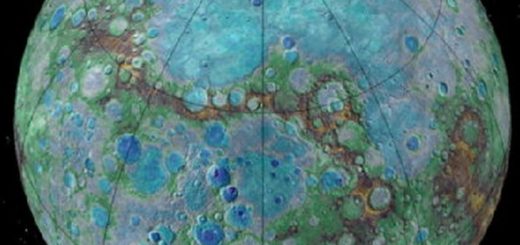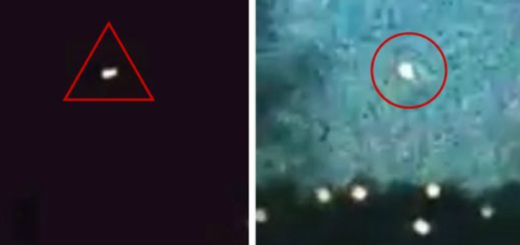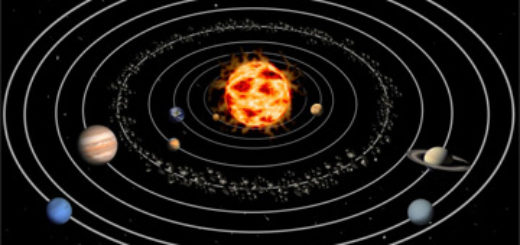Scientists’ predictions for the long-term future of the Voyager Golden Records will blow your mind

Buckle up, everyone, and let’s take a ride on a universe-size time machine.
The future is a slippery thing, but sometimes physics can help. And while human destiny will remain ever unknown, the fate of two of our artifacts can be calculated in staggering detail.
Those artifacts are the engraved “Golden Records” strapped to NASA’s twin Voyager spacecraft, which have passed into interstellar space. Although the spacecraft will likely fall silent in a few years, the records will remain. Nick Oberg, a doctoral candidate at the Kapteyn Astronomical Institute in the Netherlands, and a colleague wanted to calculate which (if any) stars the two Voyager spacecraft may encounter in the long future of our galaxy.
But the models let them forecast much, much farther into the future. Oberg presented their work at the 237th meeting of the American Astronomical Society, held virtually due to the coronavirus pandemic, on Jan. 12, where he spun a tale of the long future of the twin Voyagers and their Golden Records.
NASA launched Voyager 1 and Voyager 2 in 1977 to trek across the solar system. On each was a 12-inch (30 centimeters) large gold-plated copper disk. The brainchild of famed astronomer Carl Sagan, the Golden Records were engraved with music and photographs meant to represent Earth and its humans to any intelligent beings the spacecraft meet on their long journeys. Both spacecraft visited Jupiter and Saturn, then the twins parted ways: Voyager 1 studied Saturn’s moon Titan while Voyager 2 swung past Uranus and Neptune.
In 2012, Voyager 1 passed through the heliopause that marks the edge of the sun’s solar wind and entered interstellar space; in 2018, Voyager 2 did so as well. Now, the two spacecraft are chugging through the vast outer reaches of the solar system. They continue to send signals back to Earth, updating humans about their adventures far beyond the planets, although those bulletins may cease in a few years, as the spacecraft are both running low on power.
But their journeys are far from over.
Oberg and his colleague combined tracking the Voyagers’ trajectories forward with studying the environments the spacecraft will fly through to estimate the odds of the Golden Records surviving their adventures while remaining legible. The result is a forecast that stretches beyond not just humanity’s likely extinction, but also beyond the collision of the Milky Way with the neighboring Andromeda galaxy — beyond even the extinction of most stars.
Milky Way sightseein
Unsurprisingly, the duo’s research ambitions didn’t start out quite so vast. The new research was inspired by the release of the second batch of data from the European Space Agency’s spacecraft Gaia, which specializes in mapping more than a billion stars super precisely.
“Our original goal was to determine with a very high precision which stars the Voyagers might one day closely encounter using the at the time newly released Gaia catalog of stars,” Oberg said during his presentation. So he and his co-author began by tracing the Voyagers’ journeys to date and projecting their trajectories out into the future.
But don’t get excited for any upcoming milestones. Not until about 20,000 years from now will the Voyagers pass through the Oort cloud — the shell of comets and icy rubble that orbits the sun at a distance of up to 100,000 astronomical units, or 100,000 times the average Earth-sun distance — finally waving goodbye to its solar system of origin.
“At that point for the first time the craft will begin to feel the gravitational pull of other stars more strongly than that of our own sun,” Oberg said.
It’s another 10,000 years before the spacecraft actually come near an alien star, specifically a red dwarf star called Ross 248. That flyby will occur about 30,000 years from now, Oberg said, although it might be a stretch to say that the spacecraft will pass by that star. “It’s actually more like Ross 248 shooting past the nearly stationary Voyagers,” he said.
By 500 million years from now, the solar system and the Voyagers alike will complete a full orbit through the Milky Way. There’s no way to predict what will have happened on Earth’s surface by then, but it’s a timespan on the scale of the formation and destruction of Pangaea and other supercontinents, Oberg said.
Throughout this galactic orbit, the Voyager spacecraft will oscillate up and down, with Voyager 1 doing so more dramatically than its twin. According to these models, Voyager 1 will travel so far above the main disk of the galaxy that it will see stars at just half the density as we do.
Odds of destruction
The same difference in vertical motion will also shape the differing odds each spacecraft’s Golden Record has of survival.
The records were designed to last, meant to survive perhaps a billion years in space: beneath the golden sheen is a protective aluminum casing and, below that, the engraved copper disks themselves. But to truly understand how long these objects may survive, you have to know what conditions they’ll experience, and that means knowing where they will be.
Specifically, Oberg and his colleague needed to know how much time the spacecraft would spend swathed in the Milky Way’s vast clouds of interstellar dust, which he called “one of the few phenomena that could actually act to damage the spacecraft.”
It’s a grim scenario, dust pounding into the Voyagers at a speed of a few miles or kilometers per second. “The grains will act as a steady rain that slowly chips away at the skin of the spacecraft,” Oberg said. “A dust grain only one-thousandth of a millimeter across will still leave a small vaporized crater when it impacts.”
Voyager 1’s vertical oscillations mean that spacecraft will spend more time above and below the plane of the galaxy, where the clouds are thickest. Oberg and his colleague simulated thousands of times over the paths of the two spacecraft and their encounters with the dust clouds, modeling the damage the Golden Records would incur along the way.
voyager 1
An image of one of the covers of the twin Golden Records, meant to protect the playable surfaces from the hazards of space. (Image credit: NASA/JPL-Caltech)
That work also requires taking into consideration the possibility that a cloud’s gravity might tug at one of the Voyagers’ trajectories, Oberg said. “The clouds have so much mass concentrated in one place that they actually may act to bend the trajectory of the spacecraft and fling them into new orbits — sometimes much farther out, sometimes even deeper toward the galactic core.”
Both Golden Records have good odds of remaining legible, since their engraved sides are tucked away against the spacecraft bodies. The outer surface of Voyager 1’s record is more likely to erode away, but the information on Voyager 2’s record is more likely to become illegible, Oberg said.
“The main reason for this is because the orbit that Voyager 2 is flung into is more chaotic, and it’s significantly more difficult to predict with any certainty of exactly what sort of environment it’s going to be flying through,” he said.
But despite the onslaught and potential detours, “Both Golden Records are highly likely to survive at least partially intact for a span of over 5 billion years,” Oberg said.
After the Milky Way’s end
After those 5 billion years, modeling is tricky. That’s when the Milky Way is due to collide with its massive neighbor, the Andromeda galaxy, and things get messy. “The orderly spiral shape will be severely warped, and possibly destroyed entirely,” Oberg said. The Voyagers will be caught up in the merger, with the details difficult to predict so far in advance.
Meanwhile, the vicarious sightseeing continues. Oberg and his colleague calculated that in this 5-billion-year model-friendly period, each of the Voyagers likely visits a star besides our sun within about 150 times the distance between Earth and the sun, or three times the distance between the sun and Pluto at the dwarf planet’s most distant point.
Precisely which star that might be, however, is tricky — it may not even be a star we know today.
“While neither Voyager is likely to get particularly close to any star before the galaxies collide, the craft are likely to at least pass through the outskirts of some [star] system,” Oberg said. “The very strange part is that that actually might be a system that does not yet exist, of a star that has yet to be born.”
Such are the perils of working on a scale of billions of years.
From here, the Voyagers’ fate depends on the conditions of the galactic merger, Oberg said.
The collision itself might kick a spacecraft out of the newly monstrous galaxy — a one in five chance, he said — although it would remain stuck in the neighborhood. If that occurs, the biggest threat to the Golden Records would become collisions with high-energy cosmic rays and the odd molecule of hot gas, Oberg said; these impacts would be rarer than the dust that characterized their damage inside the Milky Way.
Inside the combined galaxy, the Voyagers’ fate would depend on how much dust is left behind by the merger; Oberg said that may well be minimal as star formation and explosion both slow, reducing the amount of dust flung into the galaxy.
Depending on their luck with this dust, the Voyagers may be able to ride out trillions of trillions of trillions of years, long enough to cruise through a truly alien cosmos, Oberg said.
“Such a distant time is far beyond the point where stars have exhausted their fuel and star formation has ceased in its entirety in the universe,” he said. “The Voyagers will be drifting through what would be, to us, a completely unrecognizable galaxy, free of so-called main-sequence stars, populated almost exclusively by black holes and stellar remnants such as a white dwarfs and neutron stars.”
It’s a dark future, Oberg added. “The only source of significant illumination in this epoch will be supernovas that results from the once-in-a-trillion-year collision between these stellar remnants that still populate the galaxy,” he said. “Our work, found on these records, thus may bear witness to these isolated flashes in the dark.”



 Creators of mankind
Creators of mankind Description of “Tall white aliens”
Description of “Tall white aliens” Where they came from?
Where they came from? About hostile civilizations
About hostile civilizations The war for the Earth
The war for the Earth “Tall white aliens” about eternal life
“Tall white aliens” about eternal life Video: “Nordic aliens”
Video: “Nordic aliens” Aliens
Aliens Alien encounters
Alien encounters The aliens base
The aliens base UFO
UFO Technology UFO
Technology UFO Underground civilization
Underground civilization Ancient alien artifacts
Ancient alien artifacts Military and UFO
Military and UFO Mysteries and hypotheses
Mysteries and hypotheses Scientific facts
Scientific facts


















